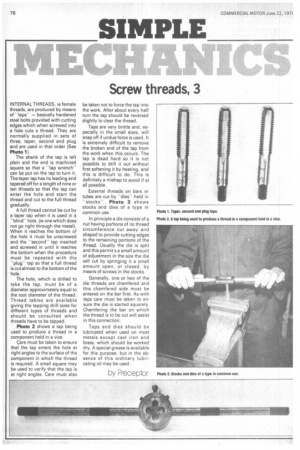Screw threads, 3
Page 80

If you've noticed an error in this article please click here to report it so we can fix it.
INTERNAL THREADS, ie female threads, are produced by means of "taps" — basically hardened steel bolts provided with cutting edges which when screwed into a hole cuts a thread, They are normally supplied in sets of three, taper, second and plug and are used in that order (See Photo 1).
The shank of the tap is left plain and the end is machined square so that a "tap wrench" can be put on the tap to turn it. The taper tap has its leading end tapered off for a length of nine or ten threads so that the tap can enter the hole and start the thread and cut to the full thread gradually.
A full thread cannot be cut by a taper tap when it is used in a "blind" hole, (ie one which does not go right through the metal). When it reaches the bottom of the hole it must be unscrewed and the "second" tap inserted and screwed in until it reaches the bottom when the procedure must be repeated with the "plug" tap so that a full thread is cut almost to the bottom of the hole.
The hole, which is drilled to take the tap, must be of a diameter approximately equal to the root diameter of the thread. Thread tables are available giving the tapping drill sizes for different types of threads and should be consulted when threads have to be tapped.
Photo 2 shows a tap being used to produce a thread in a component held in a vice.
Care must be taken to ensure that the tap enters the hole at right angles to the surface of the component in which the thread is required. A small square may be used to verify that the tap is at right angles. Care must also be taken not to force the tap into the work. After about every half turn the tap should be reversed slightly to clear the thread.
Taps are very brittle and, especially in the small sizes, will snap off if undue force is used. It is extremely difficult to remove the broken end of the tap from the work when this occurs. The tap is dead hard so it is not possible to drill it out without first softening it by heating, and this is difficult to do. This is definitely a mishap to avoid if at all possible.
External threads on bars or tubes are cut by "dies" held in "stocks''. Photo 3 shows stocks and dies of a type in common use.
In principle a die consists of a nut having portions of its thread circumference cut away and shaped to provide cutting edges to the remaining portions of the thread. Usually the die is split and this permit s a small amount of adjustment in the size the die will cut by springing it a small amount open, or closed, by means of screws in the stocks.
Generally, one or two of the die threads are chamfered and this chamfered side must be entered on the bar first. As with taps care must be taken to ensure the die is started squarely. Chamfering the bar on which the thread is to be cut will assist in this connection.
Taps and dies should be lubricated when used on most metals except cast iron and brass, which should be worked dry. A special grease is available for this purpose, but in the absence of this ordinary lubricating oil may be used.
by Preceptor




























































































































































































